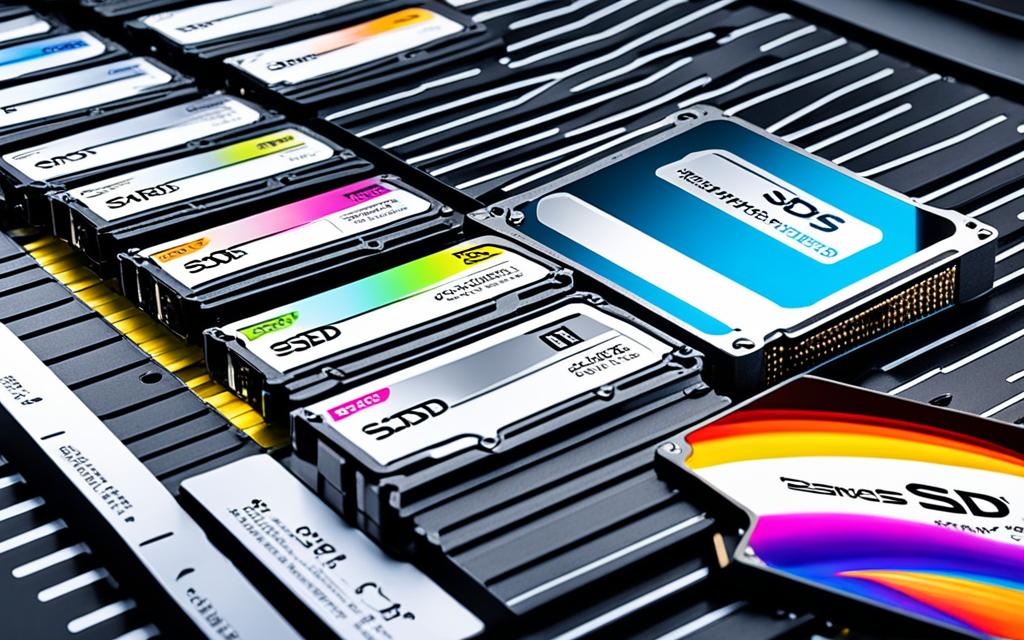Table of Contents
In our tech-driven world, knowing how many SSDs your PC can handle is key for upgrade seekers. SSDs change how we store data with their speed and efficiency. PC SSD support depends on the motherboard, connectors, and space in your case. This article explains the limits and best setups for SSDs in PCs. For deeper insights, look at this comprehensive guide1.
Key Takeaways
- Motherboard specs play a big role in how many SSDs a PC can have.
- SSDs are faster and better for system upgrades than old hard drives.
- PCs with several M.2 slots can take more SSDs, boosting their speed.
- Ensure your power supply can handle multiple SSDs to keep performance up.
- RAID setups can greatly enhance SSD speed and data safety.
Introduction to Solid State Drives (SSDs)
Solid State Drives, or SSDs, are changing how we store data with their flash memory. This makes them faster at accessing data than old hard drives. They have no moving parts. This means they start up quick and load games and apps faster. Gamers, content creators, and professionals find them very useful for their quick data access. For more information on SSDs, you can learn more.
What are SSDs?
SSDs use new tech to speed up computers. They are more reliable and last longer than old hard drives. They are tougher, use less power, and help save energy. Their prices have fallen, making them more available. But, NAND SSDs can run into issues after many uses, which might shorten their life. Looking ahead, SSDs are expected to hold up to 200 TB by 2024. That’s a huge jump from the 45 MB they started with in 199123.
Factors Determining the Number of SSDs a PC Can Support
The capacity of a PC to fit more SSDs mostly depends on its motherboard specifications. The motherboard has various storage connectors such as SATA and M.2 for SSDs. You’ll find 4 to 6 SATA slots in most motherboards, letting you install up to 6 hard drives4. Meanwhile, M.2 slots offer faster data transfer, boosting performance and SSD compatibility5.
PCs can also use PCIe slots to add more SSDs, improving speed in handling data. Using many SSDs distributes the workload, speeding up reading and writing times. This boost is great for demanding apps, benefiting both enthusiasts and professionals5. The main perks of multiple SSDs are speed, organisation, reliability, and better data security.
It’s also key to think about the physical space in your PC case, as small cases might limit drive numbers. Regular maintenance keeps SSDs running smoothly and long-lasting5. Plus, SSDs use less power and are cooler than traditional hard drives, making your PC hardware more efficient4.
How Many SSD Can a PC Have
The number of SSDs a PC can hold depends on a few things. This includes the SSD connectors you have and how much room is in the PC case. Knowing about these will help you put SSDs in your system the right way.
Types of Connectors
Different SSD connectors mean your PC can have various numbers of drives. The most seen connectors are M.2 and SATA. SATA SSDs have speeds around 500 MB/s. Yet, they take up more space and keep you from adding many drives6. M.2 SSDs, however, are smaller and can go up to a big 2TB7. They also work faster, with some NVMe M.2 SSDs reaching speeds of 7,300 MB/s read and 7,000 MB/s write for PCIe 4.07. With smaller M.2 connectors, you can fit more drives without losing space.
Physical Space Considerations
The size of your PC case plays a big role in how many SSDs you can have. Big full-tower cases can hold a lot of SSDs easily. But, small mini-ITX cases might only fit one or two8. Some fancy ATX motherboards have space for up to six SSDs. This gives you lots of room to add more8. You can also use PCIe SSD adapter cards. They let you connect more SSDs straight to the motherboard’s PCIe slots for even more growth8. But, it’s important to not only look at how many SSDs you have but also how they are set up. This makes sure they cool down well and the air moves properly.
The Importance of Power Supply Capacity
When you’re building or improving a PC, especially if it has many SSDs, the power supply unit capacity becomes really important. Every SSD adds to the total SSD energy consumption, affecting the PSU’s load. SATA SSDs use about 2 to 3 watts, while M.2 NVMe drives use 3.5 to 7 watts. Knowing these numbers helps you figure out the right PSU size. This avoids power supply issues that can cause shutdowns or instability.
It’s crucial to remember that a modern PSU should only be used up to 80% of its capacity for the best performance and longer life of parts9. When you’re picking out a PSU, you need to add up the power needed by drives, the motherboard, CPU, and any extra peripherals. The total power can be around 35 watts for each drive. Motherboards use about 25 watts, and the CPU’s needs vary.
To make sure your power efficiency is as good as it can be, multiply your total power needs by 1.259. This extra step creates a safety net for when your PC is working hard. Going for the cheapest, smallest PSU can backfire, putting your expensive parts in danger. A high-quality PSU, like the SeaSonic G-series, offers great voltage control and reliability. This protects your investment in your PC’s performance10.
With many SSDs in a system, having the right power supply is key. Working close to your PSU’s limit can cause voltage drops and lead to failures. Adding an extra power supply can offer protection for big setups9.
Conclusion
It’s vital to know how many SSDs your PC can handle. This knowledge improves both performance and storage. When checking the motherboard specs, you make sure the SSDs fit well. Most new motherboards, like ATX types, have several places for SSDs. They even support RAID for faster speed and data safety118.
Also, picking the proper SSD interface matters a lot. Choices like SATA, M.2, or PCIe affect how fast your PC runs11. Adding more SSDs speeds up your computer. This is great news for both gamers and pros.
To wrap up, whether upgrading or just boosting your PC, this guide is handy. Knowing what your system can do lets you find the best mix of power and speed for your needs118.
FAQ
What factors influence the maximum number of SSDs a PC can support?
The number of SSDs a PC can handle depends on the motherboard, connector types, PC case space, and the power supply. Checking each part’s compatibility is key to setting up SSDs properly.
How do I determine if my motherboard is compatible with SSDs?
To check if a motherboard supports SSDs, look at its specs for SATA and M.2 connectors. This shows how many SSDs you can add. Also, see if it has NVMe support for top speed and performance.
Can I mix different types of SSDs in my PC?
Yes, mixing SSDs like SATA and NVMe is often possible if your motherboard allows it. Just remember each type’s performance and connection limits to get the best mix of speed and storage.
What is the significance of SSD power consumption when adding more drives?
Considering SSD power use is key when adding more. SATA SSDs use about 2 to 3 watts, while M.2 NVMe uses 3.5 to 7 watts. Make sure your power supply can handle the extra load for stable performance.
How can I optimise my PC’s performance after installing additional SSDs?
To boost your PC’s speed with more SSDs, install them correctly, manage cooling, and use the right data protocols. This makes your PC faster for games, creating content, or everyday tasks.
Source Links
- https://forum.level1techs.com/t/max-supported-ssd/197919 – Max supported SSD
- https://www.techtarget.com/searchstorage/definition/SSD-solid-state-drive – What is an SSD (Solid-State Drive)?
- https://en.wikipedia.org/wiki/Solid-state_drive – Solid-state drive
- https://www.partitionwizard.com/partitionmagic/how-many-hard-drives-can-a-pc-have.html – How Many Hard Drives Can a PC Have? Influencing Factors & Add/Use – MiniTool Partition Wizard
- https://medium.com/@techfocuspro/how-many-ssds-can-a-pc-have-details-by-techfocuspro-127233074232 – How Many SSDs Can a PC Have | Details by Techfocuspro
- https://www.sabrepc.com/blog/Computer-Hardware/how-to-add-m-2-nvme-ssd-to-your-motherboard – How to Add M.2 NVMe SSDs to your Motherboard
- https://www.kingston.com/en/blog/pc-performance/two-types-m2-vs-ssd – 2 Types of M.2 SSDs: SATA and NVMe- Kingston Technology
- https://softwareg.com.au/blogs/computer-hardware/how-many-ssd-slots-does-a-motherboard-have – How Many Ssd Slots Does A Motherboard Have
- https://www.truenas.com/community/threads/proper-power-supply-sizing-guidance.38811/ – Proper Power Supply Sizing Guidance
- https://www.inmotionhosting.com/blog/power-supply-units/ – PSUs: Understanding Power Supply Units
- https://upfrontupdates.com/how-many-ssd-can-a-pc-have/ – How Many SSD Can a PC Have? A Comprehensive Guide








